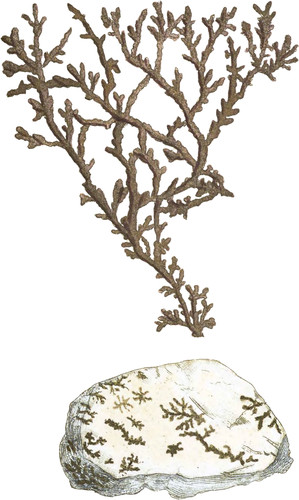 Enlarge
Enlarge
British Mineralogy
Dendritical Copper
- Class 3. Metals.
- Ord. 1. Ductile.
- Gen. 4. Copper.
- Spec. 1. Native.
- Div. 2. Imitative.
- Syn.
- Cuprum nativum. Waller, p. 274. Lynn. Syst. ed. 12. v. 3. 143.
- Gediegen kupfer. Emmerling, v. 2. 206.
- Cuivre natif. De Lisle, v. 3. 305. Haüy, v. 3. 518.
- Native copper. Kirwan, v. 2. 128.
Not uncommon at the Lizard and other places in Cornwall, in the crevaces of quartzose rocks, or in serpentine, and is occasionally found in North Wales, &c. It accommodates itself in all directions to the smallest openings, ramifying, or inosculating, as in the specimen figured, or forming network. It is generally so compressed as to have the impression of the stone on the surface, giving breadth to the extremities, not unaptly resembling foliage, which is often helped by the tendancy of the metal to crystallize. This it always partly does, but in so confused in a way that it can only be understood by comparison with such specimens as have had more room to crystallize. This will be readily understood by the figure of what I have called Arborescent Copper.
Copper is so well known in Great Britain as scarcely to need a description. The fresh fracture is very hackly, mostly brighter, and lighter in colour, than the outside, which is often stained or cankered. It is however sometimes found so pure, or bright, that it changes but little; and the fracture will hardly show a difference of colour, if carefully kept. Hardness 6–8, Kirw. Steel cuts it neatly, whence it is made into plates for engraving on. It is soluble in acids; and aquaforts is used by artists to etch upon it with the help of wax, not unlike the operation spoken of under the article Fluor, tab. xi. of this work. It is manufactured for many purposes, as common coin and kitchen utensils, but is not now so much used for culinary purposes as formerly. It forms a compound metal with tin and zinc, called brass. It is readily drawn into wire, which is very tough and durable. A wire one-tenth of an inch in diameter will sustain 2991/2 pounds weight.

